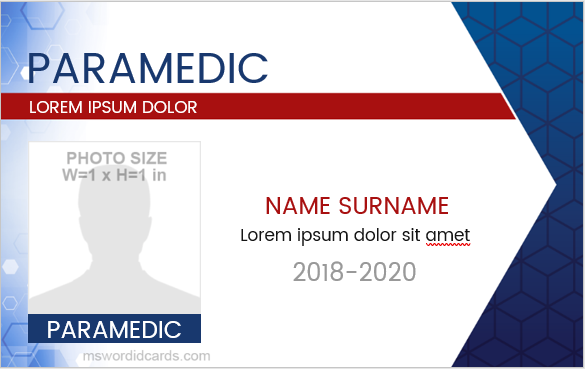An emergency identification card (EID), also known as a security ID card or personal identification card, is a temporary proof of identity, typically made on-site by a doctor or nurse in the case of medical emergencies. The EID is used along with other safety supplies like allergy inhalers, throat sprays, mouth guards and other allergy supplies to ensure the protection of those who have special needs and are at higher risk of allergies. An EID is usually held for only about sixty minutes, though some may be made for longer periods of time depending on the type of emergency being dealt with. Holding one for long periods of time poses potential dangers, as it can be easy for a person to lose their EID and become unable to access personal safety supplies that they need during an emergency.
The purpose of the emergency id card is to provide medical care and emergency assistance to people with various medical conditions, allergies, and infections. First responders and other emergency personnel can quickly identify a patient with a properly issued card. Those who receive these cards are then able to immediately identify those with allergies and other health conditions that can pose a threat to them. This process helps reduce unnecessary delays in the provision of medical treatment, which can be critical in cases where patients require emergency care in a timely manner.
An Emergency Contact List, or EIC, is typically included on each Emergency Identification Card. It contains the medical information of all recipients of the card, including contacts for allergy management professionals, asthma inhalation providers, and other health care professionals. In addition, it lists the patient’s name, address, and contact information. The EIC is distributed to all emergency contacts in the area but is normally not passed out to family members unless specifically requested. Generally, an EIC is distributed at the first health department office where an emergency occurs but can be accessed by anyone who calls the number on the card.
An emergency identification card, or EIC, must be produced by a manufacturer who has received the United States Department of Health and Human Services’ approval for the product. There are currently three manufacturers in the United States, and all of them produce EICs that adhere to all of the guidelines set forth in the current federal standards. All emergency information seatbelt attachment cards must conform to certain guidelines set forth by the Consumer Product Safety Commission (CPSC). Furthermore, all emergency identification cards that are printed must be signed by a notary public. Finally, all emergency information seatbelt attachment cards must be laminated with a water-resistant seal.
One of the most important aspects of an EIC is to contain important medical information about allergies. An emergency information seatbelt attachment for medical identification cards may have a hypoallergenic symbol, which will allow allergy specialists to quickly determine whether a person is receiving treatment for allergies. Many allergies may cause symptoms like those of other health conditions, but if a person is suffering from allergies that manifest themselves in a health emergency, the proper medical attention should be given first. In this case, the emergency identification cards will specify that the person be given a specific allergy medication before undergoing surgery or after losing consciousness due to a medical condition.
Another important feature of an EIC is to provide an alternative view of the emergency information seatbelt attachment according to the present invention. For example, some people suffer from vision problems that prevent them from seeing a checklist of their items in the hospital’s inventory. The emergency information seatbelt attachment can be seen from a third perspective, even though it is viewed through the eyes of the person who must read it. This allows people with vision impairments to access the list of their possessions during hospitalization without having to read the list from the top, or from the bottom, if the list is printed on paper. In addition, it allows doctors to look at an image of a person’s body during surgery, or at a scene of the crime, without having to physically look at the person or the scene.
An EIC does not need to contain the same layout as traditional ID badges. In fact, if the same basic layout is used, then it becomes easier for medical staff to identify and count patients when processing the medical records. In addition, the design of the emergency information seatbelt attachment does not need to include lines for numerical data. The numbers could be placed along the width of the badge, or they could be placed on a raised tab or list of data. There would still be spaces between the numbers, which would allow easy reading of the numbers.
In conclusion, it can be seen that there are many potential uses for free EIC templates, from business and healthcare organizations to hospitals and doctor’s offices. They can be used for creating an emergency contact list or creating a database of vital signs. Furthermore, these templates can be used in conjunction with electronic health records (EHR), which provide for the convenient and quick collection, submission, and storage of patient records.

